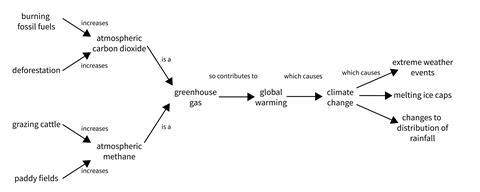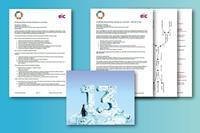Earth’s atmosphere is incredibly complex and human activities have changed its composition in ways that result in extreme changes of climate
This activity looks at the chain that leads from human action in one place to an effect on the environment in another place. Climate change is a big topic to teach, consisting of many parts, each of which is detailed and content-rich. Show your students how the parts fit together into one integrated whole by constructing a simple flow diagram. Use the questions to consolidate and check understanding.

Sustainability in chemistry

This resource accompanies the Education in Chemistry article Teach the real-world effects of climate change where you will find more support and suggestions for how to connect your current chemistry teaching with UN sustainable development goal 13: take urgent action to combat climate change and its impacts. Link directly to the goal to give this activity an engaging and relevant context.
Teacher notes
Construct the flow diagram in class to help learners better understand how the different elements they have learned about fit together. This will also give you a chance to check their understanding.

Follow these steps to help get the most from using a live drawing approach:
1. Start with a blank canvas (ie an empty board).
2. Start drawing the diagram, explaining aloud as you go.
3. Then add your label to the diagram silently.
4. Allow students to read it.
5. Bring your students’ attention back to you, and start drawing the next section.
6. Explicitly gesture and point to the bits you want students to look at while you are explaining eg by saying ‘look at this’.
7. Repeat the cycle until your diagram is complete.
Dual coding boosts memory gives more guidance and information about why drawing in front of the class helps them learn.
Using the questions
The questions in the student sheet gradually escalate in difficulty. They can be used at the end of your teaching of this topic, though many of them would be good checks for understanding throughout teaching.
The calculation questions might be particularly challenging for your learners if they don’t see how they relate to what they have learned about moles and masses. It may be worth letting them try on their own for a little bit before reminding them that the questions are analogous to ones they have already studied.
You may also need to give a little more support to some of your students for the longer-response questions to improve the success rate. This might be simple prompts, or you might want to use similar examples as a whole class activity first (eg explain why cattle farming in South America can result in forests in Siberia experiencing less rainfall).
Link to other goals covered in this series, such as Goals 15: life on land and 7: affordable and clean energy.
Get more resources
- Model the greenhouse effect with this classroom demonstration.
- Ensure your learners have a firm understanding of the chemistry behind climate change with How to teach the carbon cycle at 11–14.
- Use our organic chemistry worksheets for 14–16 years to check knowledge of the underlying chemistry of hydrocarbons and help put it into context.
- Carbon dioxide gets stoned offers more context and includes classroom activities and a DART (Directed Activity Related to Text) task.
- Link to careers with this job profile of an atmospheric chemist studying pollutants; find more inspiration with our Fixing the future video.
Downloads
Understanding climate change as a process: teacher notes
Editable handout | PDF, Size 0.42 mbUnderstanding climate change as a process: teacher notes
Editable handout | Word, Size 0.51 mbUnderstanding climate change as a process: student worksheet
Handout | PDF, Size 0.17 mbUnderstanding climate change as a process: student worksheet
Editable handout | Word, Size 0.13 mb



















No comments yet